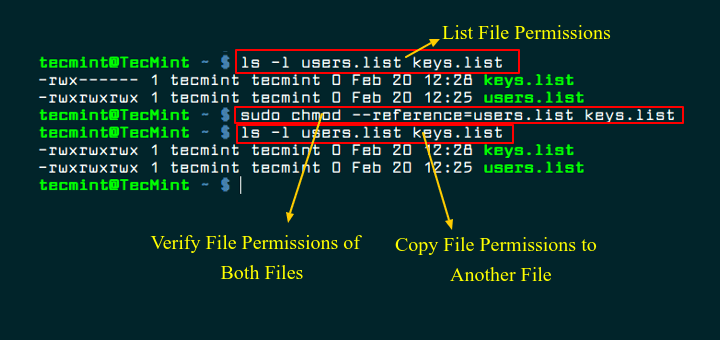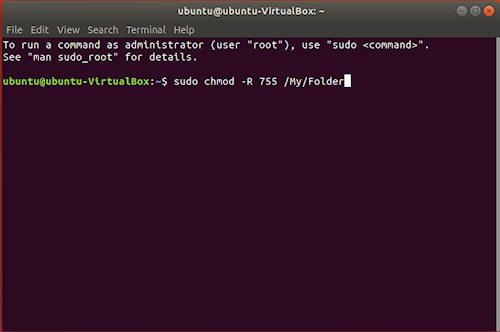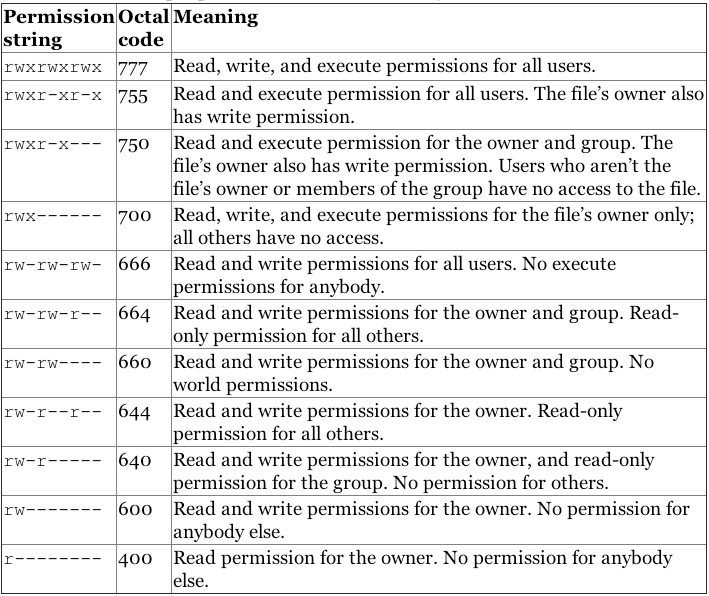Linux chmod Command Tutorial with Examples chmod Command Syntax The chmod command is used with options and files and folders It has the following syntax OPTION Display chmod Command Help Permission Calculation Before starting to use the chmod command we should learn how the permissions areIn this case, deux will belong to group canard but un will belong to the group of the user creating it, whatever that is Minor Note on the Use of Semicolons in Shell Commands Unlike C or Perl, a shell command only needs to be followed by a semicolon if there is another shell command following it on the same For example $ chmod 755 R directory_name $ chmod 755 R /home/linuxtechi/data Example 3) Assign permissions using text notation Another way of assigning permissions is by using the text notation In this method, the chmod command takes flags or symbols which represent the owner, group, others or all users ( u, g , and o) in the syntax

Chmod File Permissions In Linux Unix Linux Angular Angular Js Jquery Php Mysql And Web Development Tutorials
Chmod linux file permissions
Chmod linux file permissions-Basic "chmod" Command examples in Linux by admin The Linux command to change permissions on a file or directory is chmod, which we like to read as change file mode chmod has two operating modes symbolic mode; $ chmod u=rw,g=r,o= birthdaycgi In this file example, sets read and write permissions for user and group $ chmod ug=rw /var/www/html/dataphp See "how to use change user rights using chomod command" for more information Conclusion We explained the chown and chmod command for Linux and Unix users




Chmod 777 Tutorial The Electric Toolbox Blog
Types of permissions which we will be changing using chmod command In linux terminal, to see all the permissions to different files, type ls l command which lists the files in the working directory in long format The figure below shows an example to use ls l and its output Let us take a look at above figure Changing file permissions with chmod command using octal notation To change file permissions of a file use the syntax below chmod octal value filename For example, to change file permissions of a file file1txt, to say rwrr execute chmod 644 file1txt This is illustrated in the calculation below This tutorial explains CHMOD and CHOWN commands that are broadly used in Linux CHMOD and CHOWN The command CHMOD stands for change mode, and this is used to change the permission of a File or DirectoryThe Command CHOWN stands for Change Owner and this is used to change the ownership of a File or Directory Also Read Linux Tutorial for
Imagine by mistake you removed all permission from / (root) directory, this would lead in an unusable system;This Linux chmod command tutorial shows you to change file permissions including mode, octal and binary of files and directories with examples and syntax FChmod Linux Command & Examples The chmod Linux command is used to change the access mode (aka file system permissions) of one or more files (or directories) only the owner or a privileged user may change the mode Chmod Command Usage 1 chmod options mode files The mode can be specified by the name or the UID/ GID number, if you do not specify who then the
Chmod_Command_in_Linuxpng In Linux, access to the files is managed through the file permissions, attributes, and ownership This ensures that only authorized users and processes can access files and directories This tutorial covers how to use the chmod command to change the access permissions of files and directories Linux File Permissions Before going further, The chmod command is provided by all major Linux distributions like Ubuntu, Debian, CentOS, Mint, Kali, RHEL, SUSE, etc The chmod command has different options and parameters but the chmod x is one of the most popular and used options for the chmod For example, you have created a script file but do not know how to make it executable in order to directly call andLinux chmod Command Linux chmod command is used to change the access permissions of files and directories It stands for change mode It can not change the permission of symbolic links




Linux Commands Chmod




Linux Chmod Command Linuxfordevices
Chmod is a Unix command that lets you tell the system how much (or little) access it should permit Chmod Examples in Linux / Unix 1 Give read, write and execute permissions to everyone Read, write and execute 421=7 $ chmod 777 samplesh In the above example, you can see that the permissions are specified with a three digit number The first digit is for user permissions, second is for group and third is for others permission This type of representation is chmod Modifies File Permissions In Linux, who can do what to a file or directory is controlled through sets of permissions There are three sets of permissions One set for the owner of the file, another set for the members of the file's group, and a final set for everyone else The permissions control the actions that can be performed on the file or directory They either permit,




Linux Chmod Command Help And Examples




Chmod Command In Linux File Permissions Tecnstuff
In this tutorial I will be using preserveroot with all of my chmod commands; Unix/Linux chmod command examples to Change File Permissions Also Read 40 Best Examples of Find Command in Linux Example 1 How to check chmod command version If you want to check chmod command version then you need to use chmod version command as shown below As you can see from below output current chmod version is 2 chmod command for linux tutorial and Examples ;



1




Chmod Command In Linux With Examples Geeksforgeeks
Chmod is a great Linux command for manipulating file and directory permissions With the concepts mentioned in this article, you are equipped with sufficient knowledge to handle permissions in Linuxbased distros Yes, very right that the R option in chmod command makes the files/subdirectories under the given directory will get 777 permission But generally, it's not a good practice to give 777 to all files and dirs as it can lead to data insecurity Try to be very specific on giving all rights to all files and directories And to answer your question sudo chmod R 755 Example The command gives read, write, and execute privileges to the owner (7) and read and execute access to everyone else (55) Note In the example above, the permission is defined using the octal/numerical mode (755) Alternatively, you can utilize the symbolic mode (using alphanumerical characters) and use the command chmod R u=rwx,go=rx Example




Chown And Chmod Command Usage In Linux System Develop Paper




Linux Permissions Posix Chmod Chown Chgrp Youtube
To have combination of permissions, add required numbers For example, for read and write permission, it is 42 = 6 3 chmod Examples Give read, write and execute to everybody (user, group, and others) read, write and execute = 4 2 1 = 7 $ chmod 777 filetxt (or) $ chmod ugorwx filetxt Give execute privilege to user Leave other privileges untouched The chmod command allows you to change the permissions of files using symbolic or numeric mode To recursively operate on all files and directories under a given directory, use the chmod command with the R, (recursive) option The general syntax to recursively change the file's permissions is as follows Examples To Change group ownership In our case I am using group1 as a group in the system To change ownership we will use chown group1 file1txt You can see that the group permissions changed to group1 from root, if you use v option it will report that We just need to add a "" to change group




Linux File Permissions Tutorial How To View And Change Permission




Chmod File Permissions In Linux Unix Linux Angular Angular Js Jquery Php Mysql And Web Development Tutorials
Linux Chmod Command Tutorial with Examples To Change Permission of Files and Folders by İsmail Baydan chmod command is used to change access permission of files and directories in Linux operating systems chmod stands for change mode Access permissions specify whether a user account or group can read, write, or execute a given file and directory Also, as Anthon points out, the find command given in the other answer executes the chmod program once for each worldwritable file it finds It is slightly more efficient to say find toplevel_directory perm 2 type f exec chmod ow {} This executes chmod with many files at once, minimizing the number of execs PSHistory A chmod command first appeared in AT&T Unix version 1 As systems grew in number and types of users, accesscontrol lists were added to many file systems in addition to these most basic modes to increase flexibility The version of chmod bundled in GNU coreutils was written by David MacKenzie and Jim Meyering The chmod command has also been ported to the IBM i operating




How To Deny File Permissions To Everyone Except Yourself In Linux Linuxhostsupport




How To Use The Chmod Command On Linux
Chmod command in Linux is used to change or assign permissions on files and directories In Linux / Unix systems, accessibility to files and directories Passer au contenu jeudi, juillet 22, 21 Récents Fahrenheit to celsius #c #code #coding #program #programming #shorts #html #java #clanguage #php #c Dreamweaver and Css Tutorial Using Multiple Classes with aChmod reference= sourcefile destination file Im obigen Befehl ist die Quelldatei die Datei, deren Berechtigungsbits Sie kopieren möchten, und die Zieldatei ist die Datei, deren Berechtigungsbits Sie ändern möchten Weiter geht es mit einer numerischen Notation (auch bekannt als oktale Darstellung), mit der Sie chmod anweisen können, Berechtigungen zu ändernMacht eine Datei zusätzlich für alle ausführbar chmod R 700 /foo/bar Setz die Dateirechte rekursiv auf 700 im Ordner /foo/bar, also auf alle Dateien und Ordner die sich in /foo/bar befinden chmod u=rw,g=rw,o=r meinedateitxt Setz explizit die rechte für Besitzer und Gruppe auf lesen und schreiben und andere dürfen nur lesen




What Does Chmod 777 Mean Linuxize




How To Copy File Permissions And Ownership To Another File In Linux
Linux Solution 1 chmod R 755 will set this as permissions to all files and folders in the tree You can use the find commandTo change permission using the Linux chmod command we have to follow some syntax and rules As we discussed above we canBeispiel ls l rwrr 1 eigentümer gruppe 0 Sep 06 datei chmod rwx datei ls l rwxrxrx 1 eigentümer gruppe 0 Sep 06 datei* chmod arwx datei ls l rwxrwxrwx 1 eigentümer gruppe 0 Sep 06 datei* chmod rwx datei chmod datei new permissions are ww, not




Using Chmod X Command On Linux And Unix With Examples Systemconf




Fun With Numbers In Chmod
This is a recommended option to use when you are planning to assign permission recursively as this can be destructive;Chmod examples using octal mode First column shows the chmod command, second column shows how the value is calculated for the permission last columns of owner, group, others shows individual octal values and actual bit set on file as seen by ls l For setting any other permission combination for owner, group & other, pick corresponding value from each column and use with This article explores chmod 777, a Linux command used to give ALL RIGHTS to the user, group, and others As a new Linux user, web developer, or system administrator, you have probably been instructed to type chmod 777 /path/to/file/or/folder into your Linux shell at some point Whenever you're running commands on your systems (especially as root!), you should



Understand Linux File Permissions Using Chmod And Chown Commands Programming Tips For Versatile Coders




Restore Executable Permission To Chmod Command In Linux Ostechnix
Examples chmod 400 file Read by owner chmod 040 file Read by group chmod 004 file Read by world chmod 0 file Write by owner chmod 0 file Write by group chmod 002 file Write by world chmod 100 file execute by owner chmod 010 file execute by group chmod 001 file execute by world To combine these, just add the numbers together chmod 444 file Allow read Examples Using chmod # Below are examples of making changes to permissions chmod ux myfile Gives the user execute permission on myfile chmod x myfile Gives everyone execute permission on myfile chmod ugox myfile Same as the above command, but specifically specifies user, group and other chmod 400 myfile Gives the user read permission, andWhat is chmod Linux command chmod command or "change mode command", and as that name implies, the chmod command is used to change the mode of Unix/Linux files In other words it is used to define the way a file can be accessed chmod command Syntax chmod




How To Use Chmod Command In Linux Explained With Examples




How To Set And Manage File Permission In Linux Part 1
This is a tutorial that teaches the UNIX ®/Linux ® chmod command It presumes that you already know how to use the ls command to list the contents of a directory The tutorial has been tested with Mozilla version 18 under Linux What is chmod?I this video web will learn about file permissions in Linux We will talk about how chmod command can be used to change the file permissions File security aIt is similar to running rm rf / which if you are a Linux Administrator




Best Linux Chmod Command With Examples It Smart Tricks




Introduction To The Linux Chmod Command Opensource Com
The chmod command allows you to change the permissions on a file using either a symbolic or numeric mode or a reference file We will explain the modes in more detail later in this article The command can accept one or more files and/orChmod reference= sourcefile destination file In the above command, sourcefile is the file whose permission bits you want to copy, and destinationfile is the file whose permission bits you want to change Moving on further, there's also a numerical notation (also known as octal representation) using which you can tell chmod to change permissions




The Basics Of The Chmod Command Pi My Life Up




How To Chmod Files Only On Linux




Chmod 755 Command What Does It Do Codefather




Change File And Folder Permission On Ubuntu Chmod Chown Command In Linux Youtube




What Is Chmod X Command In Linux Linuxtect




Linux File Permission Javatpoint




Explained How To Use Chmod Command Complete Guide Youtube




How To Use Chmod Command In Linux Explained With Examples




Understanding File Permissions And Using Them To Secure Your Site




Understanding Linux Permissions And Chmod Usage




How To Use Chmod Command In Linux Explained With Examples




What Is The Meaning Of Chmod 755 And How To Execute And Verify It




Introduction To Linux File Permissions Attributes Chmod Globo Tech




Linux File Permissions And Chmod Doug Vitale Tech Blog
.png)



File Permissions In Linux Unix How To Read Write Change



Best Linux Chmod Command With Examples




Linux Terminal File Permissions Chmod Chown And Chgrp Youtube




Unix File Permissions What Is Chmod Command In Unix




Restore Executable Permission To Chmod Command In Linux Ostechnix




Understanding File Permissions What Does Chmod 777 Mean Make Tech Easier




File Chmod Gnu Png Wikipedia



Q Tbn And9gcs Trmaopb41lzfo2wl Mi6olorurkywaddbudhnw Ne1mor3ct Usqp Cau




Linux File Permissions Complete Guide Devconnected




How To Use Chmod And Chown Command In Linux Nixcraft




Linux File Permissions Tutorial For Beginners




Linux Chmod Example




How To Change Directory Permissions In Linux Pluralsight




How Did The Number 777 In Chmod 777 Come Out Under Linux Laptrinhx




Linux File Folder Permissions




11 Popular Unix Linux Chmod Command Examples To Change File Permissions Cyberithub




Your Own Linux Chmod Basics Of Files Directories Permissions And Use Of Chmod




Linux Chmod Recursive How To Change File Permissions Recursively




Linux File Permission Javatpoint




Linux Users And Groups Linode




Linux Chmod Command Tutorial For Beginners




How To Use Chmod Command In Linux Explained With Examples




Chmod Calculator For Linux File Permission




Linux Permissions An Introduction To Chmod Enable Sysadmin




Linux Chmod Command Tutorial With Examples To Change Permission Of Files And Folders Poftut
.png)



File Permissions In Linux Unix How To Read Write Change




How To Change File Folder Permissions On Linux Using Chmod




Chmod Chown Wsl Improvements Windows Command Line




Linux Chmod Chown Syntax And Chmod Chown Examples




Linux File Permissions Know The Reason Behind That Chmod 777 By Abhishek Chandra Medium




In Java How To Set File Permission On A File Using Posixfilepermission Understanding Chmod Command Crunchify



How To Chmod Files Only On Linux




Linux Chmod Command Linuxfordevices




How To Use Chmod And Chown Command In Linux




Working With File Permissions On Your Raspberry Pi Dummies




9 Quick Chmod Command Examples In Linux



Freekb Linux Commands Chmod Change A File Or Directory Standard Permissions
/GettyImages-1021092796-ea8c63ee76f84bd5bf98c4222337fbb4.jpg)



How To Use The Chmod Command In Linux




Linux Chmod Command Javatpoint




Chmod 777 In Terminal The Command To Make All Changes Affect Every File And Folder Ask Ubuntu




Chmod 777 Tutorial The Electric Toolbox Blog




Modify File Permissions With Chmod Linode
/i7guGwCYcn-34e068e148ae4e918b29c86cd2d5740e.png)



Configuring Unix Linux File And Directory Access Rights




Chmod Command In Linux With Examples Geeksforgeeks



1




Chmod Command In Linux File Permissions Linuxize




Linux Unix Permissions And Attributes Linuxsecrets




Chmod Cheatsheet Linux




Chmod 777 Or 755 Learn To Use Chmod Command With Examples




What Is Chmod X Command In Linux Linuxtect




Your Own Linux Chmod Basics Of Files Directories Permissions And Use Of Chmod




Learning The Shell Lesson 9 Permissions




How To Change Directory Permissions In Linux Pluralsight




Permissions In Linux Geeksforgeeks



Chmod Command In Unix Learn Unix Online Fresh2refresh Com




How To Run Sh File In Linux How To Use Linux




Permissions In Linux Geeksforgeeks



Csc128 Permissions And Links Chmod And Ls




9 Quick Chmod Command Examples In Linux




What Is Chmod 777 How To Change File Permissions For Linux




Linux Chmod Chown Syntax And Chmod Chown Examples




Chmod Command In Linux File Permissions Linuxize



Q Tbn And9gcs Trmaopb41lzfo2wl Mi6olorurkywaddbudhnw Ne1mor3ct Usqp Cau




How To Use The Chmod Command On Linux




14 04 Chmod Not Working In A Non Super User Ask Ubuntu




Linux Chmod Command Summary With Examples Youtube




Everything You Need To Know About Linux Chmod Command




Chmod Command In Linux Operators Used In Chmod Command In Linux



0 件のコメント:
コメントを投稿